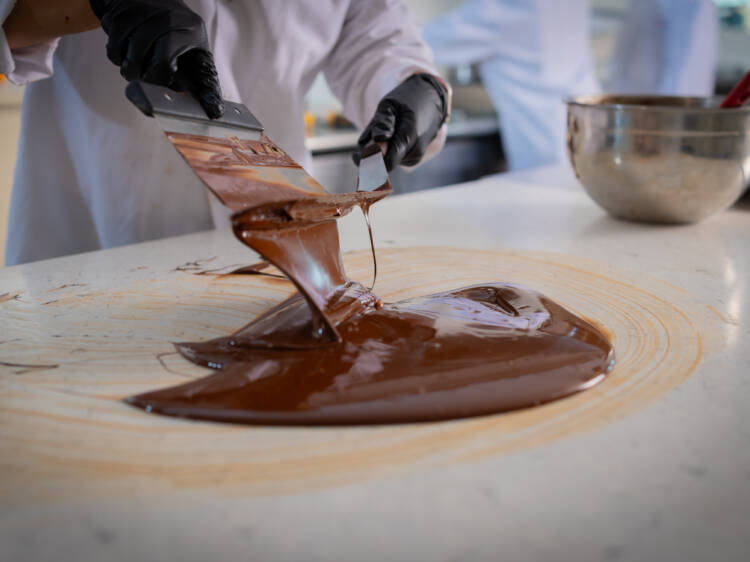Sugar Reduction in Chocolate with Fiber: Are Guilt-free Indulgences Finally Here?
by Jen Bae, Senior Scientist, Confectionary, Tate & Lyle
Consumers want to eat better but keep their indulgences
Here’s a statement most of us can agree on: people like chocolate. It’s perpetually one of the world’s most popular flavors. Research shows that 83% of consumers believe a piece of chocolate can be a great reward, and 82% consider it a “little escape.”1 It is difficult to give up something you enjoy and look forward to.
Having said that, many people want to reduce sugar in their diet overall; our data reveals that 84% of chocolate consumers have reduced their sugar intake in the last year.2 This could be about weight loss or weight management or as a measure to reduce the risk of diseases and other health issues like diabetes and heart conditions. They are more aware of food labels and pay attention to ingredient lists. And if you look at chocolate, the first ingredient is frequently sugar.
Some of the largest brands in the United States now offer reduced- or zero-sugar versions of their bars and other confections, including some that are nostalgic favorites. The demand is up, and so are the options. To me, though, reducing sugar is only the beginning. There is also an opportunity to make chocolate a healthier indulgence but with all the taste and satisfying mouthfeel of a full sugar formulation. The key to unlocking that opportunity is fiber.
Innovations in chocolate formulation
Many reduced-sugar chocolate products use maltitol, erythritol, and other types of sugar alcohol to replace the sugar. One of the drawbacks of using sugar alcohols, however, is there's a cooling effect. That might be a sensory experience you don’t want in say, a peanut butter-filled chocolate or a milk chocolate bar. For this and other reasons, some producers are looking for more attractive alternatives to reduce sugar, including fiber enhancement.
Currently, there aren’t many products that combine chocolate and fiber, with fiber as the primary replacement for sugar. That means the public doesn't know what it tastes like or what to expect. The good news is that we can make an excellent product, and when people try it, I think they'll change their minds about how good low-sugar chocolate can be.
We've tested a variety of fibers from our portfolio and learned that certain morphologies, different shapes formed by the way the fibers process, change the mouthfeel. Additionally, we’ve found that specific fibers work really well in chocolate, behaving similarly to sugar in terms of structure, so much so that most people won’t be able to tell that it's a fiber-enhanced, low-sugar product.
Overcoming technical challenges in reduced sugar chocolate
Any category in which you’re reducing sugar comes with its unique hurdles to overcome. But—and I may be biased because I specialize in it—chocolate can be especially challenging.
For example, mouthfeel is a big part of the chocolate experience. No one rushes through a chocolate bar; it’s something you savor. You want it to be smooth, melt in your mouth, and not leave anything sticking to your teeth. But with certain types of fibers, low-sugar chocolate can leave clumps in your mouth and lead to excessive tooth packing, which is food sticking between your molars when you chew. That’s definitely not what you imagine when you think of enjoying chocolate!
That’s one of the biggest challenges—there's no hiding with chocolate if you can’t replicate that complete sensory experience, particularly with solid bar chocolate, thicker bonbons, or anything premium.
For customers who want a zero-sugar product, we can mix and match different fibers to make a sugar-free formulation. However, we have noticed a difference in mouthfeel that people pick up. Our experience is that a blend of fibers will help mask even a very large reduction in sugar, making that mouthfeel change much less detectable.
Reduced sugar chocolate applications beyond the bar
Not to make anyone jealous, but I get to make chocolate as part of my job. Part of the process is refining, for which I use a three-roll refiner, and how many times it goes through depends on what I'm going to use the chocolate for. For solid chocolate, something that really has to stand up to scrutiny for texture, I’ll refine it three times. Ideally, I want a particle size of under 25 microns, and I can readily achieve this with our PROMITOR® Soluble Corn Fiber 85 and 70 spray dried or EUOLIGO® FOS fibers.
For other applications, however, such as inclusions or coatings, we don’t need to refine the chocolate as much. That’s because there are other flavors and textures imparted along with the chocolate that can mask any “imperfections.” A recent example from the prototype pantry is our No Sugar Added Milk Chocolate Caramel Chew, where the chocolate shell contains a chewy caramel log enrobed with chocolate. It’s a delicious, decadent-tasting treat, but with only 1g of total sugars in a serving and a very welcome 10g of dietary fiber.
We also created a chocolate coating for our Protein Fluff Bar prototype, and it’s a great example of how we can add amazing flavor and mouthfeel into the healthier snacking space. There are a lot of textures at play, including caramel, a marshmallow-like fluff, and the chocolate coating. That means we don’t have to strive for a premium finish—with such thin chocolate, tooth packing isn’t such a concern—and we can easily use a no-sugar formulation. Incidentally, there are just 2g of total sugars in the entire bar, plus 14g of dietary fiber and 13g of protein. It’s highly satisfying and very tasty!
Looking at even more varied uses, we experimented with putting fiber-enriched chocolate in mousse, and it works in a lot of baking applications, like brownies and cakes. I put it in chocolate chunk cookies, and it was really good. The bottom line is we can make a versatile array of chocolate formulations for most commercial sectors.
Providing the Benefits While Preserving the Experience
We have a lot of flexibility when it comes to replacing sugar with fiber. We are capable of replacing 100% of the sugar in chocolate with fiber, or, if it’s preferred, we can leave some residual sugars, maybe two to three grams per serving. So, depending on what you choose, you will be able to make one of these claims about sugar: zero sugar, no sugar added, or reduced sugar. And because we’re using fiber, this allows additional claims, usually at least “good source of fiber” and sometimes even “excellent source of fiber.” Those are very compelling callouts for consumers; in our proprietary research, over one-third of chocolate consumers said an “added fiber claim” would positively impact their purchase decision.2
Of course, because we're removing sugar, we have to consider how to restore the sweetness; at the end of the day, chocolate is sweet unless you’re talking about, say, 90% cocoa dark chocolate. That means adding high-intensity sweeteners to our formulations is also very important.
We’ve found that sucralose works very well in our reduced-sugar chocolate applications. As an alternative, we’ve also had great success blending with stevia. We have a few different types of stevia in our portfolio, and we know which work best in chocolate to leave a very minimal aftertaste.
Importantly, because taste is king and the chocolate experience is crucial to consumers, after replacing sugar with fiber and adding high-intensity sweeteners, we can deliver an exceptional product. The only difference you might note with fiber-enriched chocolate is that it can be thicker than its full-sugar counterparts. We can make milk chocolate, dark chocolate, white chocolate—and in almost any form you like. For example, we've made bonbons that are beautifully colored, shiny, and with a really good snap.
What Does the Future of Reduced Sugar Chocolate Look Like?
For our customers in the United States, allulose is a very exciting ingredient. It has 70% of the sweetness of sugar and functions very much like it in formulations and in terms of taste and mouthfeel, but with about a tenth of the calories and zero glycemic impact. In chocolate, it acts like sugar and works well when mixed with fiber. The benefits extend to the label, too; the FDA has determined that allulose is exempt from the Sugars and Added Sugars categories on nutrition labels.
Allulose, like our DOLCIA PRIMA® line of products, is currently approved for use in 14 countries, including the US, Mexico, and parts of South America, the Caribbean, and Asia. I expect that in the next few years, allulose will be approved for use globally. This would be a game-changer and open the floodgates for new product development.
In future, I think we’ll also see fiber-enriched chocolate used more in other applications, like nutrition bars and granola bars. That's something that I really believe in; customers will want it because it means less sugar while maintaining the indulgence in treats, convenient snacks, and better-for-you products.
The demand for reduced-sugar options when buying chocolate has, unfortunately, largely been met with disappointing products. That no longer needs to be the case. Thanks to our formulation advancements using fibers and high-intensity sweeteners, we can deliver on consumer expectations for an enjoyable chocolate experience in any application, from bars to baked goods. If you can’t enjoy your chocolate, why are you eating it?
Contact us now to learn more about the latest in sugar reduction in chocolate and how we can create a custom solution tailored for your consumers.
- NCA Sweet Insights, State of Treating 2024
- Tate & Lyle, US Ingredient Perception Research, 2024;

